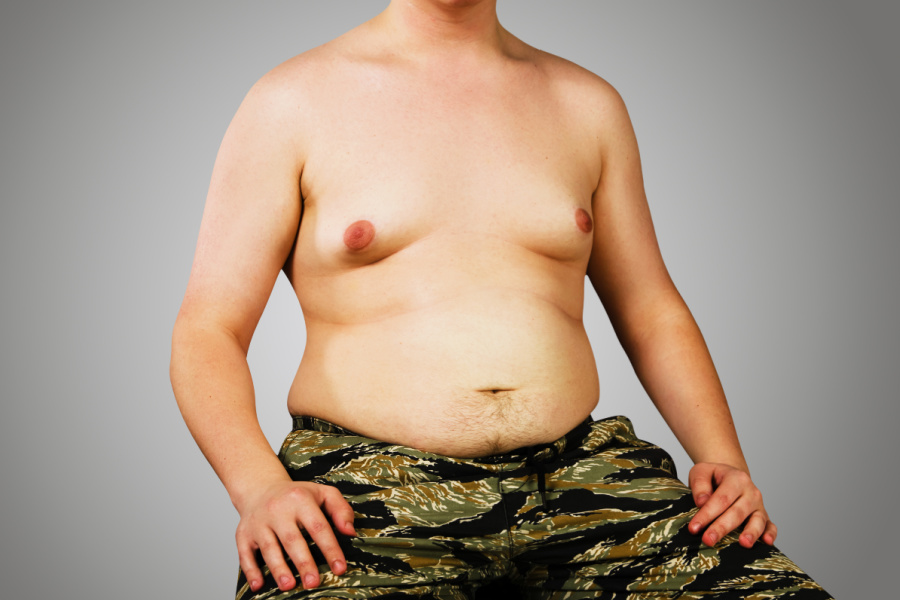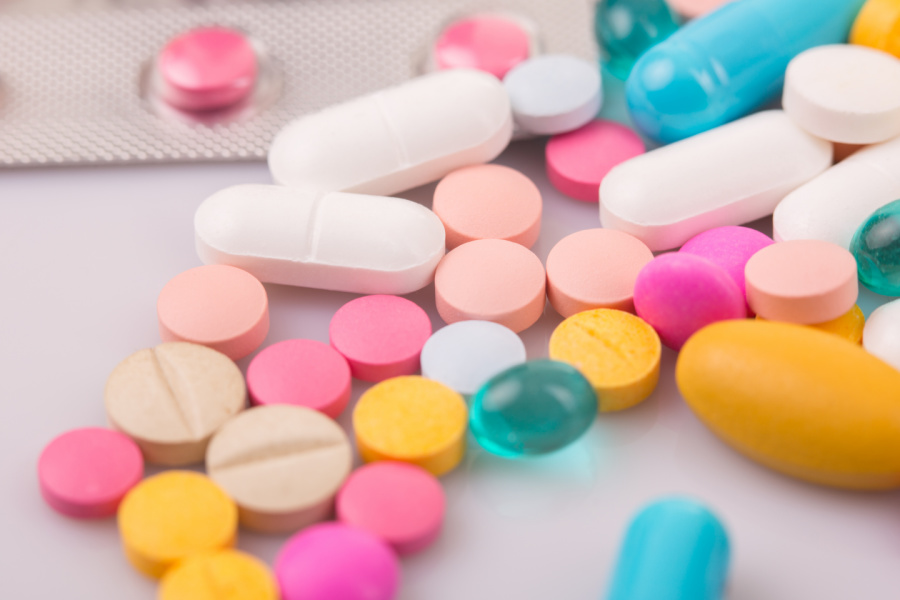
Gynecomastia differs from ordinary chest fat in that it usually doesn’t respond to lifestyle changes like diet and exercise. Instead, it’s caused by an overdevelopment of glandular breast tissue, often linked to hormonal imbalances.
Many men feel self-conscious about having excess breast tissue and look for ways to reduce it. The goal of achieving a flatter, more defined chest is a common one.
Before considering treatment options such as surgery, it’s important to understand the underlying cause. In this guide, we’ll explore the key differences between gynecomastia and chest fat—and how to tell them apart.
But first, what exactly is gynecomastia?

Gynecomastia refers to the enlargement of breast tissue in males, often mistaken for regular chest fat. While it can be linked to weight gain, the underlying cause is typically a hormonal imbalance—particularly a reduction in male hormones (androgens) or an increase in oestrogen.
This condition can affect one or both sides of the chest and may develop during puberty, later in life, or as a side effect of certain medications or health conditions.
Common signs and symptoms of gynecomastia include:
While gynecomastia isn’t usually harmful, it can affect confidence and self-image—prompting many to seek treatment.
Gynecomastia is more common than many people realise, affecting males at various stages of life—from adolescence through to older adulthood. In some cases, particularly during puberty, it can resolve on its own. In others, however, the condition persists and may only be corrected through cosmetic surgery.
Unlike chest fat, which is typically the result of excess weight and can be reduced through diet and exercise, gynecomastia involves the growth of glandular breast tissue. This is often driven by an underlying hormonal imbalance or other contributing factors.
Hormonal imbalance is the most common cause of gynecomastia and can occur at virtually any age.
Even newborn boys can develop temporary breast tissue due to elevated levels of oestrogen passed from the mother during pregnancy. This condition, often referred to as “breast buds,” typically resolves on its own within a few weeks or months.
In preteens and adolescents, similar changes may happen just before or during puberty. Pubertal gynecomastia is quite common and usually resolves naturally within six months to two years, as hormone levels stabilise.
However, for some males, gynecomastia continues into adulthood. In these cases, persistent hormone imbalances are often to blame. An excess of oestrogen relative to testosterone can lead to the growth of glandular breast tissue. Occasionally, underlying medical conditions such as tumours of the adrenal glands, pituitary gland, or testes—as well as liver disease—may contribute to the imbalance.
No matter the cause, the common thread is a disruption in the body’s natural hormone levels—typically too much oestrogen and not enough testosterone. Identifying and addressing this imbalance is crucial for effective treatment.

Gynecomastia can also be a side effect of certain medications, particularly those that alter hormone levels or interfere with androgen activity.
Some drugs may increase oestrogen levels or stimulate the production of hormones like prolactin. Others may reduce or block the effects of androgens such as testosterone and dihydrotestosterone (DHT). Since androgens help counterbalance oestrogen, medications that suppress these hormones can allow oestrogen to exert a stronger influence—leading to the development of glandular breast tissue.
Medications commonly associated with gynecomastia include:
In addition to prescription medications, some natural products have also raised concerns. Herbal supplements and essential oils, particularly tea tree oil and lavender oil, have been linked to hormonal effects that may contribute to gynecomastia in some individuals.
If you suspect medication may be playing a role in breast tissue development, speak with your doctor. Never stop a prescribed medication without medical guidance.
As mentioned earlier, certain health conditions—particularly those that affect hormone production—can contribute to the development of gynecomastia.
Hormone-sensitive cancers such as adrenal gland tumours, pituitary tumours, and testicular cancer can all disrupt the balance of oestrogen and testosterone, leading to an increase in glandular breast tissue. An overactive thyroid (hyperthyroidism) may also play a role by increasing levels of specific hormones that influence breast growth. In some cases, lung cancer has been linked to hormonal imbalances that may trigger gynecomastia.
Liver-related conditions are another common factor. The liver plays a key role in regulating hormones, and when it’s compromised—as in cirrhosis or liver cancer—oestrogen levels can rise, prompting breast tissue to enlarge. Cirrhosis, often linked to chronic alcohol use, is a well-known contributor to hormone disruption.
In all cases, proper medical evaluation is essential to identify any underlying conditions that may be contributing to gynecomastia. Addressing the root cause is often the first step toward effective treatment.
Beyond prescription medications, the use of recreational drugs and certain substances can also contribute to the development of gynecomastia.
Excessive alcohol consumption is a well-known factor, as it can interfere with liver function and hormone regulation. In particular, alcohol may increase oestrogen levels while reducing testosterone production—an imbalance that can lead to the growth of breast tissue.
Other substances commonly linked to gynecomastia include:
These substances can disrupt the body's natural hormone balance, either by reducing androgen levels or increasing oestrogen activity. Long-term use or high doses tend to carry the greatest risk. If substance use is suspected to be a contributing factor, reducing or discontinuing use—under appropriate medical guidance—may help prevent further development.
It’s completely normal for boys to develop some degree of breast tissue during puberty or even in the years just before it, known as precocious puberty.
Precocious puberty refers to early hormonal changes that begin before the age of 9. In contrast, typical male puberty usually starts around age 9 and continues until roughly 15 or 16. During these stages, the body undergoes rapid growth and significant hormonal fluctuations—both of which can temporarily cause the development of breast buds or mild swelling in the chest area.
In most cases, this is a harmless and temporary part of development. Unless the tissue becomes painful or persists beyond adolescence, no treatment is typically required. Reassurance and monitoring are usually all that’s needed as the body naturally rebalances its hormones over time.
Is the excess tissue on your chest gynecomastia or just chest fat?
This is a question we hear often — and it’s understandable. Many men come to us hoping to reduce the unwanted tissue on their chests. It can be a source of self-consciousness, especially when wearing tighter clothing, going shirtless at the beach, or sporting thin fabrics that highlight body contours.
If you’re wondering whether the fullness in your chest is due to gynecomastia or simply fat, here are 7 important questions to consider that can help you better understand what’s causing it.

1. What’s your age?
If you’re a young male going through puberty or haven’t yet, excess chest tissue or fat is often just part of your development. Surgery is usually not recommended during this time because hormonal changes typically resolve the issue naturally by age 15 or 16. Maintaining a balanced diet and regular exercise can help speed this process.
On the other hand, older men may develop excess breast tissue later in life due to natural testosterone decline—especially those who are overweight or obese.
2. Do you have excess body fat?
Doctors often assess overall body composition to distinguish between gynecomastia and chest fat. Overweight or obese men usually carry fat in various areas, including the chest. Even men who appear lean might have a higher body fat percentage despite a slim frame, a condition sometimes called “skinny fat.” Blood tests revealing high triglycerides, low “good” HDL cholesterol, or high “bad” LDL cholesterol can also indicate higher body fat, which may contribute to chest fullness.
3. Do you have any medical conditions?
Gynecomastia can be linked to certain health issues, particularly those affecting hormones. Conditions like an overactive thyroid or cancers involving the testicles, pituitary gland, or adrenal glands may cause hormonal imbalances that lead to excess breast tissue. Liver and lung diseases—including cirrhosis and kidney failure—can also play a role.
4. Have you had your hormones checked recently?
Hormonal imbalances often go unnoticed. If you or your doctor suspect that excess estrogen or low testosterone might be causing gynecomastia, a simple blood test can provide answers. Testosterone is typically measured in the morning, and results usually come back within a few days.
5. What’s your diet like?
A diet high in unhealthy fats and processed foods can increase body fat, including in the chest area—even if your weight is within a normal range. Aim for a balanced diet rich in protein, whole grains, fruits, vegetables, and healthy fats to help manage your body composition and reduce excess tissue.
6. How often do you exercise?
Regular exercise, especially strength training targeting the chest muscles, can improve muscle definition and reduce the appearance of excess tissue. If your chest fullness is mild, focusing on pectoral workouts might help you achieve a firmer, flatter chest.
7. Do you drink alcohol frequently or use substances?
Excessive alcohol consumption and the use of substances such as opioids, marijuana, and amphetamines have been linked to gynecomastia. If substance use is a concern, seeking support from healthcare professionals, trusted friends, or family can be an important step toward recovery and better health.
At the Minor Surgery Clinic, gynaecomastia surgery often involves the excision technique and VASER liposuction—especially for patients with dense glandular breast tissue that cannot be effectively treated with liposuction alone. This surgical method allows for the precise removal of firm breast tissue through a small, discreet incision made along the edge of the areola, helping to minimise visible scarring. The excision approach creates a smoother, flatter, and more masculine chest contour. The procedure usually takes between 1 to 2 hours and is performed under local anaesthetic, ensuring you are comfortable throughout. After your surgery, our expert surgical and cosmetic nursing team will provide personalised aftercare instructions to support your recovery, protect your incisions, and reduce scarring for the best aesthetic results.
Everything you need to know about Gynaecomastia surgery
What is gynaecomastia surgery?
Gynaecomastia surgery, or male breast reduction, is a procedure that removes excess breast tissue in men to create a flatter, more masculine chest contour.
Who is a good candidate for gynaecomastia surgery?
Ideal candidates are men over 18 with persistent excess breast tissue causing discomfort or self-consciousness, and who are in good overall health.
What is the recovery process like?
Patients can expect some soreness for a few days, return to light activity within a couple of days, and full recovery in about six weeks while wearing a compression vest for 6 to 8 weeks.
Will there be scars?
Incisions are made around the areola and are designed to be discreet. Over time, scars typically fade and become less noticeable.
Can I return to work quickly?
Most patients take about one week off work, depending on the physical demands of their job.
Is gynaecomastia surgery covered by the NHS in London?
NHS coverage is no longer available, so patients opt for private treatment from a trusted and experienced clinic